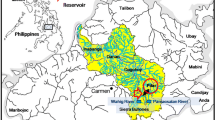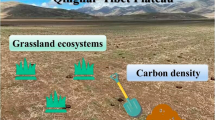Summary
Capillary barriers, consisting of fine-over-coarse soil layers, are being considered as an alternative cover component for waste-disposal facilities, especially in dry climates. Infiltrating water is removed from the fine layer by evaporation or transpiration, or percolation into the coarse layer (failure). If the fine-coarse interface is sloped, water in the fine layer can also drain laterally under unsaturated conditions. The effectiveness of two capillary barriers in laterally diverting water was tested. The barriers were 7 m long and 1.2 m thick, built on a 10% slope. One had a homogeneous fine layer, while the fine layer of the other was layered to increase its ability to divert water laterally. The barriers were first subjected to constant infiltration (10 mm/day) followed by exposure to ambient climatic conditions. The layered capillary barrier was successful in laterally diverting water near the interface and did not permit any water to enter the coarse layer. In contrast, the homogeneous capillary barrier failed over its entire length. These results indicate that a significant lateral diversion capacity can be designed into capillary barriers, greatly increasing their effectiveness.
Similar content being viewed by others
References
Baker, R.S. and Hillel, D. (1990) Laboratory tests of a theory of fingering during infiltration into layered soils, Soil Science Society of America Journal, 54, 20–30.
Code of Federal Regulations (1992) 40 CFR, Protection of Environment, The Office of the Federal Register National Archives and Records Administration, US Printing Office, Washington, DC.
Daniel, D.E. (1994) Surface barriers: problems, solutions, and future needs, in Proceedings of the Thirty-Third Hanford Symposium on Health and the Environment, Pasco, WA Vol. 1, Gee, G.W. and Wing, N.R. (eds.), Battelle Press, Columbus, pp. 441–87.
Fayer, M.J., Rockhold, M.L. and Campbell, M.D. (1992) Hydrologic modeling of protective barriers: comparison of field data and simulation results, Soil Science Society of America Journal, 56, 690–700.
Fredlund, D.F. and Barbour, S.L. (1992) Integrated seepage modelling and slope stability analyses: a generalized approach for saturated/unsaturated soils, in Geomechanics and Water Engineering in Environmental Management, Chowdhury, R.N., (ed.), A.A. Balkema, Rotterdam, pp. 3–35.
Goode, D.J. (1986) Selection of soils for wick effect covers, in Symposium of Geotechnical and Geohydrological Aspects of Waste Management, Fort Collins, CO, A.A. Balkema, Rotterdam pp. 101–9.
Hakonson, T.E., Maines, K.L., Warren, R.W., Bostick, K.V., Trujillo, G., Kent, J.S. and Lane, L.J. (1994) Hydrologic evaluation of four landfill cover designs at Hill Air Force Base, Utah Report LAUR-93-4469, Los Alamos National Laboratory, Los Alamos, NM.
McTigue, D.F. (1994) Estimation of unsaturated hydraulic properties by inversion of moisture content data from a field infiltration experiment, an internal report for Sandia National Laboratories, Albuquerque, NM.
Mualem, Y. (1976) A new model for predicting the hydraulic conductivity of porous media, Water Resources Research, 12, 513–22.
Nyhan, J.W., Hakonson, T.E. and Drennon, B.J. (1990) A water balance study of two landfill cover designs for semiarid regions, Journal of Environmental Quality, 19, 281–8.
Pease, R.E. (1995) Increasing the lateral diversion capacity of capillary barriers, MSc Thesis, University of New Mexico, Albuquerque, NM.
Ross, B. (1990) The diversion capacity of capillary barriers, Water Resources Research, 26, 2625–9.
Sherard, J.L., Dunnigan, L.P. and Talbot, J.R. (1984) Basic properties of sand and gravel filters, Journal of Geotechnical Engineering, ASCE 110, 684–700.
Steenhuis, T.S., Parlange, J.-Y. and Kung, K.-J.S. (1991) Comment on ‘The diversion capacity of capillary barriers’ by B. Ross, Water Resources Research, 27, 2155–6.
Stormont, J.C. (1995a) The effect of constant anisotropy on capillary barrier performance, Water Resources Research, 31, 783–5.
Stormont, J.C. (1995b) The performance of two capillary barriers during constant infiltration, in Landfill Closures.Y.Y. Environmental Protection and Land Recovery, Geotechnical Special Publication No. 53, Dunn, R.J. and Singh, U.P. (eds.), ASCE, New York, pp. 77–92.
Suter, G.W., Luxmoore, R.J. and Smith, E.D. (1993) Compacted soil barriers at abandoned landfill sites are likely to fail in the long term, Journal of Environmental Quality, 22, 217–26.
Troxler Electronics Laboratories (1993) Comparing the Sentry 200-AP and the Model 4300 moisture probes, Troxler Technical Brief, Research Triangle Park, NC.
van Genuchten, M.Th. (1980) A closed-form equation for predicting the hydraulic conductivity of unsaturated soils, Soil Science Society of America Journal, 44, 892–8.
Wing, N.R. (1993) Permanent isolation surface barrier: functional performance, Report WHC-EP-0650, Westinghouse Hanford Corporation, Hanford, WA.
Wing, N.R. and Gee, G.W. (1994) Quest for the perfect cap, Civil Engineering, October, 38–41.
Author information
Authors and Affiliations
Rights and permissions
About this article
Cite this article
Stormont, J.C. The effectiveness of two capillary barriers on a 10% slope. Geotech Geol Eng 14, 243–267 (1996). https://doi.org/10.1007/BF00421943
Received:
Accepted:
Issue Date:
DOI: https://doi.org/10.1007/BF00421943




